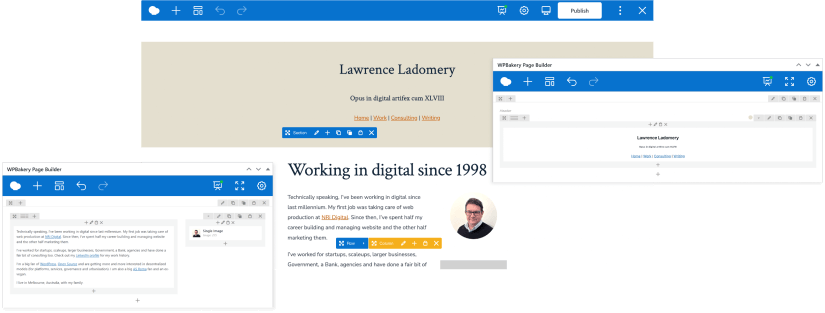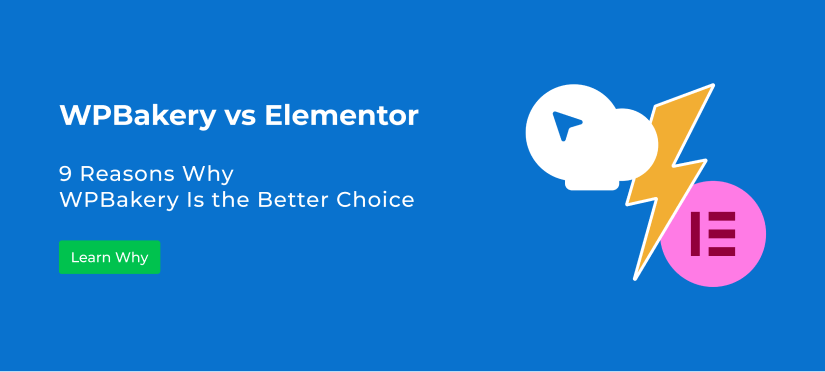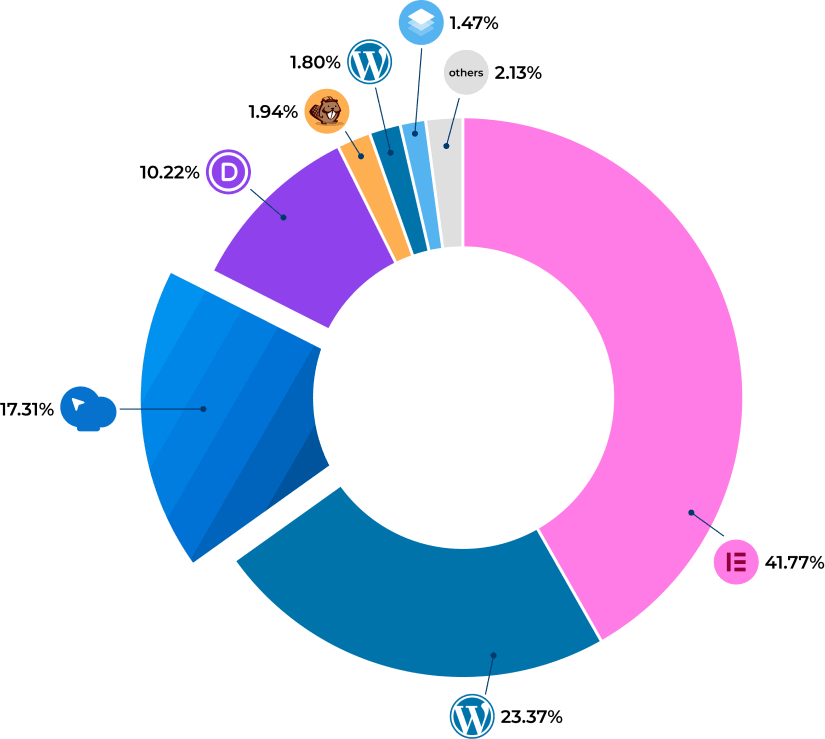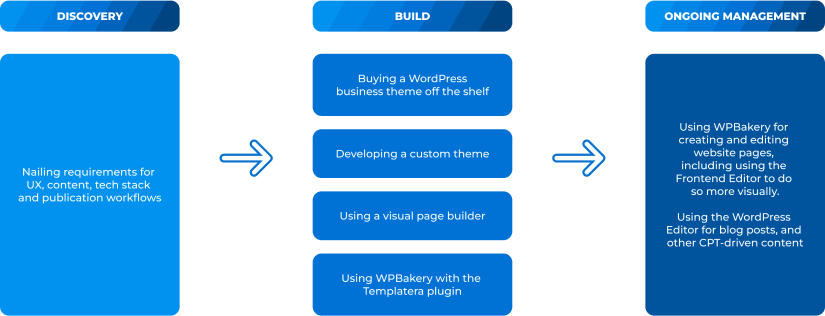Why Businesses and Agencies Choose WPBakery
A quick intro: I am WPBakery’s new Marketing Specialist and will be working alongside Nikola to promote the brand and engage with the community. Over the past couple of weeks, and as part of my onboarding, I’ve spent most of my time digging deep into the product, its users and looking at our competitors. So I thought that I would kick off my contribution to this blog by covering what I have learned, but also tapping into my 20+ years building, managing and marketing websites.
I’m not new to WPBakery. I first used it 12 years ago when I bought the Stockholm theme on Themeforest, and I have recently re-built my personal website with it. I have also used many other WordPress page builders, and a multitude of CMS, including the first one I ever used at the start of my career which was a custom solution built with Microsoft Access. I’m sharing this so you can appreciate that I have quite a broad perspective when it comes to systems and processes to publish online.
Who are Business Users and how do they use WordPress?
I’ll start with a definition to frame the various points I’ll be making, thinking about the different people I have worked with over the years on website projects, in organizations large and small. Let me know in a comment if I have missed anyone.
Thinking about the types of Business Users and how the use WordPress:
- Solopreneur or Micro business owner
Purchase a theme that can be easily updated or hire the cheapest dev they can find. - Marketer responsible for a company’s website
Manage the design and build of a website, and ongoing updates, including creating new pages. - Contributors
Subject matter experts that publish content through some kind of WordPress workflow. - Creatives
Designers and videographers creating assets requested by Marketers and Contributors. - SEOs
Optimize pages created by Marketers and contributors.
Now, here’s a list of who is not a Business User:
- IT staff responsible for hosting, security and keeping WordPress up to date
- Builders – designers and developers build websites based on briefs from Marketing
- Makers – solopreneurs who either have development or design skills, or are keen to learn to them
What is also clear is that there are two distinct functions a page builder has: development and content management.
Tip: if you are an agency: learn what your client’s workflows are (or should be), and what skills they have, before choosing the best tech for the job.
Different Page Builders Serve Different Types of Users
Next, I’ll ‘map’ users, as defined above, to the three types of WordPress page builders that exist:
- Drag and drop page builders such as WPBakey, Visual Composer, Divi and Avada
- Visual page builders such as Elementor, Bricks Builder, Breakdance and Oxygen
- Block-based page builders such as Kadence, Stackable and WordPress’ own Full Site Editing functionality
Some drag and drop page builders offer WYSIWYG options too, like WPBakery’s Front End Editor. And visual page builders describe themselves as ‘drag and drop’, so the above definitions somewhat overlap. There’s no agreed categorization or nomenclature for the different types of page builders in the WordPress ecosystem, so feel free to correct me via a comment if you can come up with better ones.
With this in mind, here’s who uses what:
Drag and drop page builders are used by Business Users. Their no or low-code UIs make it very easy for them to create and maintain pages.
Visual page builders are primarily used by Builders and Makers. They have the technical skills to build a website from scratch.
Block-based page builders should be for all to use but have been embraced mostly by Builders and Makers. The Gutenberg UI is still quite hard for Business Users to use, which is why the Classic Editor plugin (that disables it) is one of the most downloaded ones.
An additional point about Gutenberg. While the Block Editor has been hailed as the future of WordPress, its adoption is still limited. An analysis of 729K WP Engine websites shows a negligible number that have been built using the Full Site Editor. WPBakery, instead, was used on close to 7% of all websites.
How about Elementor? It can and is used by Business Users!
Absolutely. And I’ll share this too: I’m a fan of Elementor! I used to run their Meetup here in Melbourne a few years ago. I know it well.
I observed two types of people attending the Meetups I organized: agency folks happy about how much faster Elementor allowed them to build client websites, and ‘Business Users’ who didn’t quite know where to start or were stuck and looking for help.
I think it’s fair to say that Elementor is closer to a design tool like Figma than a system for managing content. The learning curve for non-developers and non-designers is steep, which is why we get feedback like this all the time:
“I used Elementor for a while and once I started using WPBakery I couldn’t believe how much easier it is for us.”
Asha Sterling, COO, Elaine Sterling Institute
Of course, Elementor can be used to create websites that non-technical users can easily update. Typically, the approach is to let them update content via WordPress’ own editor. Perhaps even creating Custom Post Types for different content types, and making the most of custom fields. This works well until a change to the layout of a page is required, or a new landing page is needed. A ‘Builder’ needs to be engaged for that, which will cost time and/or money.
WPBakery: a Tried and Tested Tool for Business Users. Since 2011.
WPBakery was developed at a time when themes ruled the WordPress world. Businesses either installed an existing theme from WordPress.org, bought one from a marketplace like ThemeForest, or had one custom built.
WPBakery was conceived as a drag and drop tool for Business Users to easily create and update pages within the ‘structural’ constraints and style definition of the selected theme. Any theme, in fact.
The product has evolved and innovated a great deal, of course, but the laser-focus on Business Users needs remains:
- Ease of use
- Simple and intuitive, with little or no training needed
- Time saving
- Flexible and modular
- Innovative
WPBakery is the steel reinforcement WordPress needs so Business Users can create and update pages quickly without having to worry about breaking things. It offers just the right level of control over design and layout for the creative freedom they need to deliver great experiences to website visitors and customers.

WPBakery allows you to switch from a more ‘structural’ view of a page, to front-end WYSIWYG editing.
A quick note about innovation. Last year we introduced WPBakery AI, a digital assistant deeply embedded into the platform. Most page builders have an AI offering, indeed. But ours is particularly extensive and generous. Check out how it compares Vs the likes of Elementor, Divi and Jetpack. It will get smarter too, as we add capabilities. We have other exciting new features planned for the page builder in 2025. Stay tuned.
WPBakery is used by close to 6 million websites
It’s the third most popular page builder, or second if you don’t count WordPress default builder – the Block Editor.
Why is this important? Adoption is a measure of how successful a product is, particularly over time. It indicates maturity and resilience in changing market conditions. Businesses are risk averse, particularly when it comes to technology.
Management wants to avoid scenarios such as Cwicly’s sudden announcement earlier this year that they would stop development altogether. They’ve had a change of heart since then, but no IT manager, or even solopreneur, wants to receive an email from the founder of a mission-critical application announcing development would cease immediately.
WPBakery’s numbers are reassuring:
- It’s been around since 2009
- It’s used, or has been used, on 5,800,000 websites (source: BuiltWith)
- It’s supported by a team of 20+ WordPress pros
- It has grown an ecosystem of third-party add ons
- It’s profitable and growing
Let’s address the elephant in the room. While the perception in the industry is that WPBakery is a legacy product, the truth is that it’s a solid product that works well for its intended audience.
The analogy that comes to mind is the BMW Series 3 model, which isn’t perhaps the most exciting of the German automaker’s line up, and has iterated conservatively over time, yet retaining its reliability, performance and elegance.
Or, as one of our customers recently said:
“In a landscape where many developers began building their own visual interfaces, I often found myself missing the intuitive and robust experience that WPBakery consistently provided. While other tools often felt clumsy and limiting, WPBakery has always stood out for its ease of use, reliability, and innovative features. It has been a cornerstone in my web development process, allowing me to bring my creative visions to life with efficiency and precision.”
– Michael Ryden, Composer, Educator & Filmmaker – michaelryden.com
A Valuable Tool for Customer-Centric Agencies
It’s true that visual page builders have sped up the design and build process. But that’s half of the story. Have they streamlined what happens once a website has been delivered to a client? The content management part, that is.
Everyone agrees that the most successful agencies are the ones that address and solve their client’s pains. They start projects with Discovery to understand business requirements and commercial goals. They don’t plan to deliver just a pretty website, but a system that can be easily maintained, expanded and doesn’t drain internal resources. Agencies that promise a great UX should also deliver a great publishing experience.
I’ll be talking to our partner agencies and prospective ones about this. Pitching the idea that the Theme + WPBakery combo is a compelling proposition. Here’s why:
- Keeping development and content management tools separate, which best practice
- For content management, Business Users prefer WPBakery over visual page builders and Gutenberg
- That WPBakery is secure, mature and backed by a team of Pros
- Agencies can easily build addons for their clients, and sell them to the broader WPBakery ecosystem to generate additional revenue
- Purchasing lifetime licences will save them money
Next, taking a look at how a web development project would look like:
Good to have many options, right? For the Build part, the choice will be influenced by the client’s content management requirements and their budget.
You will have noticed the third Build option: using a visual page builder. This is definitely possible with some builders but not the best approach, as you’re running two builders simultaneously. Don’t forget that WPBakery features a Front End Editor offering a visual page editing experience.
The fourth option works nicely for smaller, brochure websites. Templatera is a handy template manager for WPBakery that allows you to create, manage and set control access to your templates based on user roles or page post types.
This plugin is an amazing must have for WPBakery Page Builder. We make heavy use of it on our site. It is totally awesome for making modular content to populate in many places on the site but edit in one place. Brilliant! How can you live without this? Answer: You can’t!
— David Grishaver, Business Consultant & Strategic Partner, BDSG
The takeaway here is that WPBakery fits nicely in different development scenarios. So yes, it is good to have options.
Conclusion
In wrapping up this blog post, it’s crucial to understand that no single page builder is a one-size-fits-all solution. If there was, WordPress would turn into Wix and lose its competitive advantage.
Over the years, WPBakery has established itself by focusing on what matters most to business users: simplicity, reliability, and ease of use.
Some people may consider it a legacy solution that was sold as part of a theme bundle on Themeforest. My response to them is to consider why WPBakery was theme author’s #1 choice. Products sell because there’s a need for them in a market, and in the case of theme authors, it was giving their customers the best tool to create and update content without breaking their themes.
2025 is around the corner and we have some exciting developments in the pipeline. Rest assured that the focus on Business Users’ needs remains strong as ever.
If you haven’t tried WPBakery before, you can instantly activate your own personal preview website and take it for a test drive.
If you’re an agency and want to learn more about volume licensing and how we support our partners, get in touch with us via our Agency Program page.



